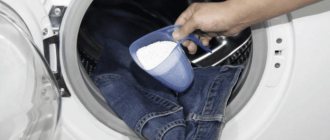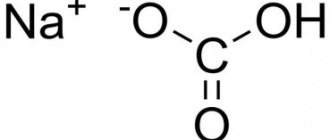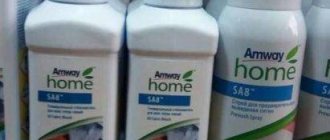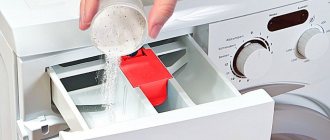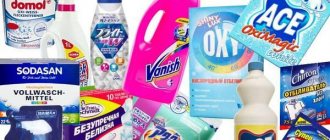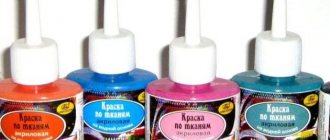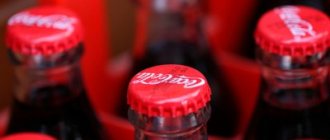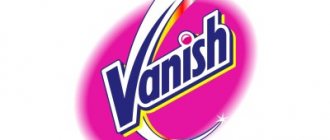White bed linen or clothing becomes grayish or yellowish after prolonged use. Previously, to eliminate this problem, every housewife used chlorine bleach called “Whiteness”. This substance perfectly bleaches and disinfects, but at the same time deprives the fabric of color and destroys the fibers. Now, to restore the original appearance, oxygen-based bleaches are used instead of chlorine. They are safe for fabric and human health.
Pros of Oxygen Bleach
Today, every housewife prefers to use oxygen-containing bleach instead of aggressive chlorine-containing stain remover. The third part of the product consists of white powdered sodium percarbonate. The active substance causes a surface oxidation reaction.
Used in professional laundries to whiten clothes and remove stains during automatic washing.
This promotes effective removal of traces of dirt and whitening. Advantages of the product:
- the main substance is active oxygen;
- low activation temperature of the bleaching process (about 30°C);
- the safety of the components allows use for children's products;
- has an antiseptic effect;
- instantly dissolves in liquid and leaves no streaks on things;
- does not destroy the tissue structure, does not wash out the color;
There are many eco-friendly laundry products.
Also, the product does not harm the environment. When the active substance decomposes, products are released that do not pollute the environment.
How to use bleach
Everyone using bleach expects to get a good effect. But if you do not follow the basic recommendations, you will not achieve the expected result.
Using special products you can whiten things.
Simple rules will help you wash any item. After basic recommendations, you can enjoy perfect cleanliness.
Handwash
If light-colored clothes are not enough for a full machine wash or there are items that require delicate care, hand washing will help out. Typically, information about the type of wash for each product is indicated on the label. Preliminary preparation will remove dirt and stains from items immediately before bleaching. The washing container can also be used for bleaching.
White items can be washed by hand.
So, let's prepare the required concentration. To do this, mix the desired solution in a separate container. The correct proportion is one part product to 30 parts water. For example, this ratio is equal to half a glass of product per 3-4 liters of water (100 ml of bleach per 3 liters of water).
Gray items can be bleached.
Don't forget about temperature indicators. Remember that the product begins to work intensively in warm water. Therefore, fill the delayed wash with liquid. Let things soak for 30 minutes. After this, rinse well and let the clothes dry.
Important! Oxygen bleach must first be dissolved in a container, and then the product itself must be placed.
You can remove stubborn stains using a special fabric bleach.
For example, a regular stain appears on your favorite blouse. It could be food, any biological fluid or paint. To remove such contamination, laundry soap is useful.
Use professional laundry detergents.
Wash the item by hand first. If this method does not help, you will have to use bleach and machine wash.
Machine washable
Anyone who has ever encountered bleaching clothes manually will say that this is a rather labor-intensive process. It is costly in time and effort. But everything is made easier by a smart assistant, which provides different washing modes. Here the question arises: how to use bleach with this type of washing to get the desired result?
If you use the standard mode, it is not a fact that you will get snow-white things. Therefore, be sure to look at the instructions that come with the smart technology. Standard models have several compartments for any product. Liquid bleach is poured into a special dispenser, not intended for the main powder.
When washing, sodium percarbonate improves the effect of the main detergent.
Once from the dispenser into the drum, oxygen fabric bleaches quickly dissolve in water and are equally distributed throughout the clothes. Before putting clothes into the machine, it is recommended to first remove all dirt. Inspect the seams for accumulated dust. This will protect the product from unnecessary stains.
A concentrated product that will help keep things clean and tidy.
Note! On sale you can find special powders with bleaches, which are recommended for use in 90% of cases.
The pre-soaking function will help restore the product to its original whiteness. Modern models are equipped with this useful option. When bleaching in a machine, do not mix white with color.
Sort your laundry by color!
Otherwise, all efforts will be in vain. Using technology, washing will not take much time. And smart technology will help restore the original appearance of any thing.
Removing stains from upholstery and carpets
If during a feast the carpet or sofa is “damaged” by spilled drinks, use oxygen bleach. Active oxygen will completely remove fresh stains from upholstery and carpet pile.
► What to do: mix powdered bleach with water (1 tablespoon per 0.5 liters) and apply to the stain using a white cloth or cotton pad. After 5 minutes, wipe the stain with a damp sponge, using light dabbing movements.
How to use it correctly
When bleaching, it is important to maintain the correct proportions of the product. They are indicated on the packaging instructions. Since the concentration is different for each manufacturer, the information will help you correctly calculate the required amount. Oxygen bleach is used at any temperature and in any washing mode.
The product helps restore the dazzling whiteness of things.
Try adding a little white to your usual powder. It will enhance the effect of the detergent. It is not recommended to mix several types of bleach when washing or pre-soaking laundry. For all types of material, only oxygen is suitable.
Ideal bleach for white shirts and other clothes.
It is prohibited to use it for bleaching items made of silk, wool, or leather. Also be careful with items that have wooden buttons or other wooden elements.
Cleaning enamel cookware
If the inside of an enamel pan is yellowed or coated with carbon deposits, boil water with oxygen bleach in it.
► What to do: pour 3-4 tablespoons of bleach into a saucepan, pour 1-2 liters of cold water and turn on the heat. After the water boils, wait 5-10 minutes, then turn off the burner and let the cookware cool. Wipe the walls with a sponge and rinse thoroughly under the tap.
Read in the blog: “10 life hacks from cleaners that will help speed up and simplify cleaning”, “I don’t want to rub: how to clean with minimal effort.”
React Like Love Haha Wow Sadness Angry
1
What is the best bleach?
When purchasing household chemicals, a large assortment makes you hesitate. In order to grasp the basic principle of high-quality bleach, you need to know all the features of each type.
Chlorine-containing products
Most housewives are confident that bleach is the only proven bleaching agent. The advantages of such bleaches:
- effective even in water at room temperature;
- fights yellowness and grayness of the material;
- affordable price;
- simplicity and ease of use;
- disinfectant effect.
Whiteness effectively washes white things.
Many people use the product not only for whitening things. It is also effective on any surface. The tiles and plumbing in the house will shine with cleanliness.
Additional Information! The first household chlorine-based bleach was released by the American company Clorox in 1922.
Chlorine substance has a sufficient number of disadvantages. To begin with, it’s worth talking about aggressiveness towards the material. They are actively used for white products made from natural fabrics. If you constantly use chlorine, the fabric fibers quickly lose their properties. This leads to yellowness and disruption of the structure of the product; accordingly, such a thing becomes thinner and then completely breaks.
“Whiteness” is a strong remedy, but it is not suitable for all types of fabrics.
Important! Chlorine bleach should not be used on silk, wool or synthetic materials. It is also not recommended to wash colored and dark clothes with it.
The toxic odor of chlorine is unpleasant and produces toxic fumes. High concentrations are harmful and can even cause poisoning. If rinsed poorly, bleach remains on things and in the future this can trigger the development of allergies. Therefore, careful use when washing underwear will not be superfluous.
Important! Do not mix chlorine with substances such as ammonia or vinegar. The reaction of such components releases toxic chlorine gas.
Whiteness is a popular means for washing gray things.
Sodium hypochlorite, contained in chlorinated formulations, harms parts in the washing machine. Constant use leads to equipment failure. The shelf life, as a rule, is not long; if the period is long, the activity of the active substance is significantly reduced.
Precautionary measures! When using the product, it is recommended to protect your hands and face from chlorine vapors. If you disinfect surfaces, be sure to ventilate the room.
Oxygen products
Such products are considered safer and more environmentally friendly, but they also give an amazing effect. Used for all types of fabrics. The whitening effect is obtained from a chemical reaction with water, as a result of which the active substances begin to act.
It contains special organic substances - optical brighteners.
The main advantages are:
- effective on any material, while it does not destroy fabric fibers or discolor;
- combines with any modern product;
- disinfectant effect, allowing to remove pathogens and unpleasant odors;
- odorless, so you can safely wash baby clothes.
The disadvantage of liquid products is the instability of the components. If you store it for more than six months from the date of production, the effectiveness of the solution is significantly reduced.
The product has whitening, stain removing and disinfecting properties.
Therefore, it is better to choose powder, as it can be stored for a long time and remains effective. The most popular oxygen bleach is persalt. Boil the product with the product and you will be delighted!
Optical brighteners
Many people, having heard the name, optical brightener, do not know what it is. The product contains substances that absorb ultraviolet radiation. Today, the optical product takes the form of a colorless or slightly colored organic product that actively emits its own light.
The product is completely rinsed, leaving no traces of chemicals on things.
Thus, the lack of rays is compensated for, which is reflected on the fabric, creating a visual impression of snow-whiteness.
Interesting! The use of fluorescent substances to make fabric white was proposed in 1929.
Please note that optical components cannot wash dirty laundry. Particles of luminescent dyes only create the illusion of a snow-white effect on the fabric. This is especially visible in sunlight under the influence of ultraviolet radiation. There are many optical devices available, each designed for a specific material. There is also a universal product.
Expensive or cheap?
The cost of oxygen-containing bleach is determined by the following factors:
- composition (for example, the introduction of a high-quality activator, which allows the bleach to work effectively at low temperatures, significantly increases its cost);
- packaging (a package is cheaper, a box is more expensive, a jar is much more expensive);
- the general level of manufacturer prices (Russian-made bleaches are an order of magnitude cheaper than imported ones);
- intensity of advertising (the cost of television broadcasting throughout the country about the magical properties of Vanish or “ACE bio + oxygen” is compensated from the consumer’s wallet).
In order to understand which bleach is the best and whether the high price of expensive bleaches is justified, we tested bleaches from different price categories, Russian and imported. We hope that the test results will allow you to make a conclusion about what to buy and whether it is worth paying more.
Rules for choosing a product
The modern market today presents many products of different formats: powder for white linen, liquid, gel. Bleaching agents consist of active substances: tensides, sodium percarbonate, optical particles. Such products do not pollute the environment and do not remain on fabric fibers. It is used not only for washing children's clothes, but also for people suffering from allergies.
Today there are even certain products for washing white laundry.
Before purchasing a product, it is recommended that you familiarize yourself with the basic selection parameters. This way you can choose a really good product:
- the release date and expiration date are of particular importance (especially for ready-made liquid solutions);
- Before use, read the instructions with basic rules;
- consider the composition and type of material;
- choose the optimal temperature for each procedure.
Only high-quality products can guarantee the safety of the process. Therefore, it is better not to save on such products. Simple rules will help you easily clean your favorite things and maintain their appearance.
How to use it correctly
Before you start using chlorine bleach, consider the following recommendations:
- Chlorine may darken metal parts, so remove them from clothing. If they cannot be removed, it is better to use a gentler solution than bleach;
- It is better to wet the fabric before placing it in the drum;
- for several contaminated items, half a glass of product in addition to the main product will be enough;
- any bleach is poured into the cuvette;
- choose a program with a temperature setting of 45˚C, if necessary, turn on the stain removal function;
- modes for wool and silk products do not include bleaching.
The product does not contain chlorine, but it effectively bleaches any fabric.
Disinfection and removal of unpleasant odors
Oxygen bleach perfectly disinfects surfaces and does not emit volatile substances harmful to health. Active oxygen also destroys not only bacteria, but also persistent unpleasant odors.
► What to do: pour water with 2-3 spoons of bleach into the cat's litter box and trash can for 20-30 minutes. Scrub the walls with a brush, drain the solution and rinse the containers thoroughly under the tap.
Folk remedies
Not only bleaching ingredients, but also proven folk methods can restore the snow-whiteness of things. For a gentle solution, the simplest means that every housewife can find are suitable.
Laundry soap
The grated half of a bar of laundry soap is combined with equal proportions of ammonia and turpentine (2 tablespoons each). Dissolve the finished mixture in ten liters of warm water and leave the laundry overnight. After this you need to wash it by hand.
Laundry soap washes natural fabrics well.
If the item is not white enough, you can boil it in a soda solution. The folk method helps to effectively clean cotton and linen products.
Baking soda
Soda solution is quite popular for whitening, especially among mothers with children. Dilute 50 grams in 1 liter of water at room temperature. soda 15 ml of ammonium solution is added to the liquid. Thoroughly dissolve the components and leave the soaked product for several hours.
Baking soda is a good stain remover for white items.
Baking soda can also be used simultaneously with the main liquid product in the machine. For this, 50 grams will be enough. soda solution.
Aspirin
The tablets are active in whitening items made from delicate fabrics and children's clothing. The method is this: grind three tablets and dissolve in 100 ml of not hot water. Wet it with a mixed solution of contamination.
Aspirin will help things become whiter.
If there are a large number of stains, you can increase the amount to ten tablets. Some people add several crushed tablets to the washing machine when washing.
Potassium permangantsovka
A solution of potassium permanganate and soap will return things snow-white. Apply a thick soap mixture to the wetted product. Pour 10 liters of liquid into a container and dissolve two tablespoons of potassium permanganate. The water temperature should be no more than 30 degrees. Leave for a couple of hours, then rinse with enough running water.
Keep out of the reach of children!
Today, any product can be ordered via online delivery. The long shelf life allows you to use one package for a long time. Bleach can remove stains not only from white and light-colored items, but also from colored items. They can be used as a separate substance or as an addition to the powder.
Choose high-quality bleaches for clothes.
Packaging matters!
With liquid bleaches everything is clear. They are placed in plastic bottles of various shapes, transparent or colored, usually with a capacity of 750 ml to 1 liter. In this case, the influence of packaging on your choice is minimal.
There are at least three packaging options for powdered bleaches.
The first, most common, is a plastic or polypropylene bag. Its contents range from 80 to 450 g. The main advantage is lightness, the ability to buy a small volume “for testing”, and low cost (packaging does not increase the cost of bleach). The main significant drawback is the fragility of the packaging: the bag can easily tear, the contents can spill out, spraying quite harmful chemical particles, which is unpleasant for everyone, and doubly unpleasant for people prone to allergies. And storing bleach in a bag is not very convenient.
The second option is a cardboard box (as for powders). The weight in boxes, as a rule, varies from 300 g to 500 g. It is much more convenient to pour bleach from such containers. The only danger is that the cardboard box may get wet.
The third option is plastic jars. This is the most convenient container: durable, airtight, and the bleach is reliably protected from moisture. But such “service” significantly affects the cost of bleach. Among the variety of products, only two are packaged in a plastic jar - Vanish Oxi Action and Neon Reflect. Their price is very high (above 170 rubles per package) and is available to a small circle of consumers.
Let us note another interesting method of packaging, which we encountered, however, only once. German Anti-Grau bleach is placed in a bag (dose for 5 kg of laundry), which you place entirely in the machine, the package dissolves. In this case, the advantage is obvious - you avoid contact with the bleach itself.

